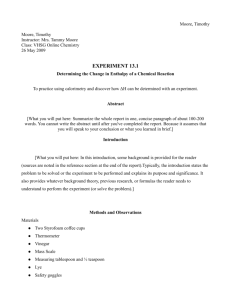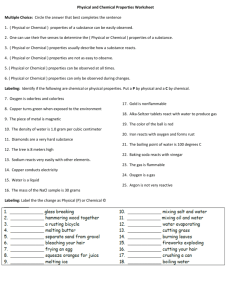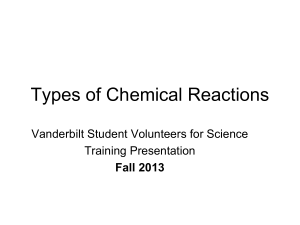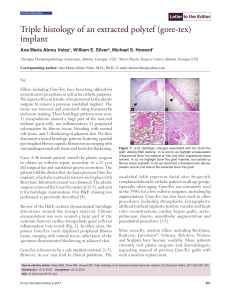except
advertisement
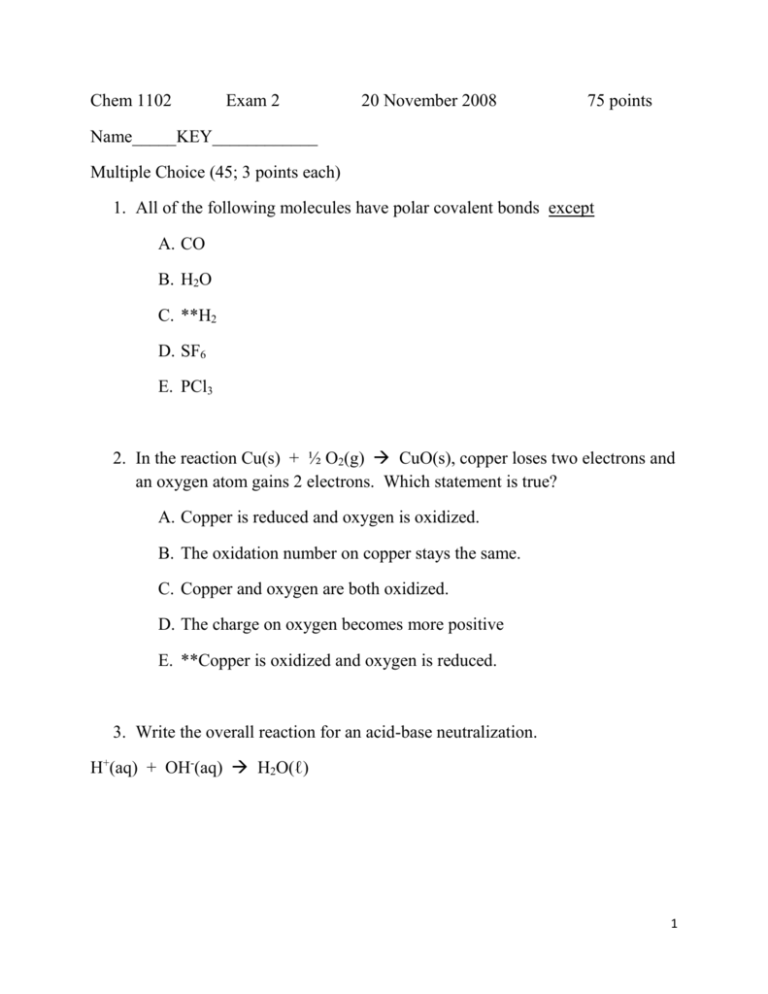
Chem 1102 Exam 2 20 November 2008 75 points Name_____KEY____________ Multiple Choice (45; 3 points each) 1. All of the following molecules have polar covalent bonds except A. CO B. H2O C. **H2 D. SF6 E. PCl3 2. In the reaction Cu(s) + ½ O2(g) CuO(s), copper loses two electrons and an oxygen atom gains 2 electrons. Which statement is true? A. Copper is reduced and oxygen is oxidized. B. The oxidation number on copper stays the same. C. Copper and oxygen are both oxidized. D. The charge on oxygen becomes more positive E. **Copper is oxidized and oxygen is reduced. 3. Write the overall reaction for an acid-base neutralization. H+(aq) + OH-(aq) H2O(ℓ) 1 4. Hydrogen bonding explains all of the following except A. **Water has a very low surface tension. B. Water has an unusually high boiling point. C. Cotton is a good absorber of water. D. Water does not dissolve capsaicin. E. Water expands upon freezing. 5. Which equation describes a precipitation reaction? A. H2O(ℓ) + CO2(g) H2CO3(aq) B. H2O2(aq) H2O(ℓ) + ½ O2(g) C. H2(g) + ½ O2(g) H2O(ℓ) D. C2H6(g) + 7/2 O2(g) 2CO2(g) + 3H2O(ℓ) E. **AgNO3(aq) + NaCl(aq) NaNO3(aq) + AgCl(s) 6. Select the statement about hydrogen bonds that is false. A. Hydrogen bonds are intermolecular bonds. B. H-bonds in water explain the water’s excellent capability to dissolve ionic and polar compounds. C. H-bonds exist between water molecules because water is a bent molecule. D. **The energy required to break the N-H bond in a molecule of NH3 is the same as the energy required to break an H-bond between two ammonia molecules. E. H-bonds explain why silicone is water-repellent. 2 7. Which statement is false about aqueous solutions? A. Many of the ions in our bodies exist and react in aqueous solutions. B. An aqueous solution is homogeneous. C. Aqueous solutions of acids have pH values less than 7. D. **Water is the solute. E. Water can dissolve some nonelectrolytes like sugar. 8. All of the following will reduce the decomposition of H2O2 except A. Low exposure to light B. **Addition of metal ions C. Cold temperature D. Storage in a plastic bottle. E. All of the above 9. The chemical that causes the green color that sometimes develops in hard boiled eggs is A. H2S B. Lecithin C. **FeS D. Albumen E. FeH2 3 10. Which statement is true about a solution with pH = 5? A. **This solution has the same pH as coffee. B. [H+] = 1.0E+5 mol H+/L soln C. This solution has the same pH as lemon juice. D. This solution contains water and ammonia. E. This solution is 5 orders of magnitude more acidic than gastric juices. 11. Which statement is false concerning the shells of mollusks? A. The shell is mainly composed of CaCO3. B. **The increase in the acidity of the oceans strengthens the shells. C. Shell color is due to the mollusk’s diet, ions in the water and ocean pollution. D. The H+ and Ca2+ ions compete to react with the CO32- ion. E. It has been proposed that shell color might offer camouflage protection, strength to the shell and/or temperature regulation. 12.Consider the pH values of milk of magnesia, vinegar, distilled water, household lye. What is the correct pH order from lowest pH to highest pH? A. milk of magnesia, vinegar, distilled water, household lye B. household lye, vinegar, distilled water, milk of magnesia C. distilled water, household lye, milk of magnesia, vinegar D. vinegar, milk of magnesia, distilled water, household lye E. **vinegar, distilled water, milk of magnesia, household lye 4 13.Identify the false statement(s) about Gore-Tex. A. The pores in Gore-Tex are much smaller than liquid water drops. B. The polymer in Gore-Tex forms strong H-bonds with water. C. Gore-Tex is a polymer made up of fluorinated ethylene monomers. D. The pores in Gore-Tex are much smaller than a water vapour molecule. E. Gore-Tex is a polymer made up of alcohol monomers. a, C b. B and D c. A and E d. B, C and D e. **B, D and E 14. All of these products are hydrophobic except A. Silicone B. **Cellulose C. Teflon D. Scotchgard E. Wax 5 15. In indigo (C16H10N2O2), which part of the molecule causes indigo to be a deep blue/violet? A. C-C B. N-H C. C-H D. **C=O E. C-N II. Essays (30 points) Write your answers in the Blue Exam Book. This is your opportunity to demonstrate what you have learned about several topics since Exam 1. You are encouraged to use pictures and chemical equations when appropriate. 1. (20) Pick two of the following observations and explain the chemical basis of the observation. Include as much material from the course as you are able. Define technical terms and give examples as appropriate. a. Water beads up on a waxed car and bubbles in Sprite are spherical. Water is a bent molecule with oxygen bonded to two hydrogen atoms. Oxygen is more electronegative so it attracts the bonding 6 electrons more than hydrogen. As a result, O has a partial negative charge (δ-) and H has a partial positive charge (δ+). This is the basis for hydrogen bonding between the more negative O of one molecule and the more positive H of another molecule. This strong network of H-bonding in water is the reason water has a very high surface tension resulting in spherical water droplets which achieves minimum surface area. This is particularly true when the water is in contact with hydrophobic wax molecules. Carbonated Sprite is mostly water but also contains gaseous CO2 which is nonpolar. Here again, water is H-bonded to other water molecules forming a spherical cavity around the CO2 bubbles. b. With time, paintings fade and/or become discoloured. What is the source of the color? What will prevent this from happening? If you spent time on a website about glaze or paint color, write about what you learned. The paints in old paintings are mainly composed of metal oxides. The source of the color is the emission of visible light following excitation from the ground to excited state of the metal. These paints or dyes fade or become discoloured when they react together, react with water in the environment, become oxidized. Museums control humidity, temperature, air quality to protect paintings. More modern paints include synthetic organic dyes. c. Only the oxidized form of indigo is blue. Include the dyeing process. Indigo is a deep purple dye extracted from a plant. The indigo molecule has two C = O groups which absorb light to go to an excited state and then emit visible purple light when it goes back to the ground state. The C = O group cannot hydrogen bond with the –OH groups on cellulose (fabric) so the indigo dye does not adhere to 7 cellulose. When indigo is reduced, the C =O group are converted to C-OH groups which form H-bonds with cellulose, thus attaching to the fabric. The reduced leuco-indigo molecule is yellowish, but when the fabric dyed with it is exposed to air and light, the leuco-indigo is oxidized to purple indigo. This method is called vat dyeing. d. Discuss the composition of glass and what contributes to strength, sparkle and stability at high temperatures. If you spent some time on the Corning website, write about what you learned. 2. (5) The title of one of the chapters in our text is “Why do Homemade Copper Cleaners use Vinegar?” In our discussion of the copper-top church and Weber Music Hall, we learned that the various colors observed on these roofs are due to compounds containing CuCO3, Cu(OH)2, and similar compounds. Based on our study of reactions that occur in water, why will vinegar remove the colors (i.e. clean the copper)? Vinegar is an acid (pH < 7, produces H+). CuCO3 and Cu(OH)2 are bases. (produces OH-, high pH > 7) . When vinegar is applied to copper covered with copper carbonate or copper hydroxide, an acid-base reaction occurs removing the copper coating and producing water. 3. (5) Describe what happens on the molecular level when solid table salt is added to water. See your notes describing this figure from Zumdahl. 8 9
